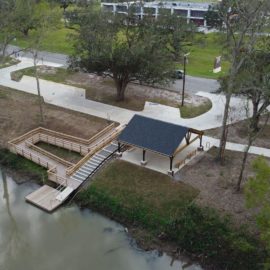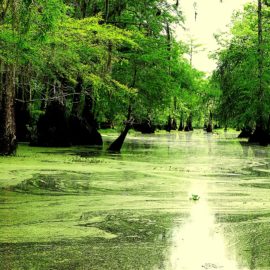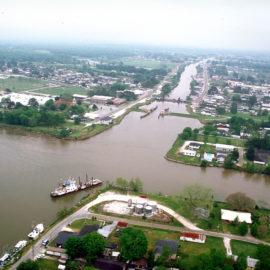
Hurricane Gustav hit the bayou and both cleared it out and blocked it up. No, not good but it started the effort to save the bayou.
Hurricane Gustav may have saved Bayou Lafourche by first nearly killing it. On Sept. 1, 2008, the Category 2 storm rammed Louisiana’s central coast and sent water surging into the bayou’s mouth. Long dammed off from the Mississippi River, the bayou had become little more than a sickly, silted-up ditch. Gustav blasted it with wind and waves, churning up muck the weakened bayou could never fully flush out. The result was a feeding frenzy for bacteria. “The water smelled horrible,” said Andrew Barron, a water-quality specialist with the Barataria-Terrebonne National Estuary Program (BTNEP). “It was very black and had a real rotten, decayed smell.” Meanwhile, waves and heavy rainfall washed contaminated soil from oil fields and other industrial sites into the bayou, causing sheens in Leeville and around Port Fourchon. As the waters receded, Gustav’s parting gift was revealed: a big mound of mud and sand pushed across the bayou’s mouth, effectively sealing up a now-toxic waterway. The bayou’s emaciated flows didn’t have the strength to push out the clog and drain the fouled waters. “The bayou went septic,” said Ben Malbrough, executive director of the Bayou Lafourche Fresh Water District.
nola.com
It wan not just the bayou that was foul but also the areas drinking water. Four parishes and 300,000 people had to boil water for a month.
“That was the ‘aha’ moment,” Malbrough said. “When you don’t have water, people start to come unglued. They finally said, ‘We gotta do something about this.’” A long-studied, long-debated and seemingly dead and buried project to revive the Mississippi’s flows into the bayou was suddenly revived. Money poured in from the federal and state government, and widespread public support materialized for the first time. The first step was to dig the bayou out of a century’s worth of built-up mud, toppled trees, invasive weeds and trash. “In some places, the channel had narrowed to only 8 feet and the rest was covered in vegetation,” said Ryan Perque, executive director of Friends of Bayou Lafourche, a group founded in 2016 to boost recreational use of the bayou. “It was so shallow you could walk across,” added Malbrough.
The dredging started in 2011 with $200 millions in surplus money from the state. Dredges was a section of bayou between Donaldsonville and Belle Rose. 16 miles have been dredged so far with another 20 to go.
The work has expanded the bayou’s capacity and allowed the district to ramp up the pump rate at the Donaldsonville station. “It was not a usable waterway before 2015, and now it’s totally transformed,” Perque said. Kayaks and canoes are an increasingly common sight, and a rowing club now plies the bayou’s waters twice a week. “The bayou is tempting now,” said Henry Templet, of the Labadieville-based Bayou Rowing Association. “People want to get out and use it now that it’s cleaner and has better flow.”
There is an increasing request for permits to build structures such as piers, bulkheads and patios at the waters edge. Also there are more pumping and pollution complaints but that is good.
“Before, people dumped all the time and nobody cared,” he said. “Now they take pride in it.” The district gets calls about septic leaks, oily sheens and people throwing trash — usually car parts and building materials — about twice a month. Prior to the improvements, the district barely got that many in a year.
Litter is a large problem especially after a heavy rain. Plastic bottles, cigarette butts and other trash sweep into the bayou. Yet, the amount it waning as there have been cleanups and more than 5,300 pieces of trash from the bayou in March. Other cleanups have garnered more trash.
Getting more people to enjoy the bayou is part of the water district’s final phase of the restoration plan. The district helped form the Friends group to develop amenities like boat launches and trails that foster closer connections to the waterway. The group is helping Nicholls State University develop its waterfront, now steeply banked and crowded with cypress knees. Set for completion this month, the $280,000 project will include a boathouse, boardwalks, float dock for kayaks and canoes and a link to a walking path. More float docks are slated for downtown Thibodaux, a park near Assumption High School in Napoleonville and the Lafourche Parish visitors center near Mathews. The Friends announced plans last month to build a motorized boat launch near the St. Charles Bypass Bridge between Thibodaux and Raceland. Construction is set to begin next year.
The local citizens are watching the transformation closely.
Retired teacher Bobby Marcello has been tracking the improvements closely. The Thibodaux native spent a recent afternoon watching a work crew rip out the first sections of the dam there. It’s a spot he fished as a kid, took girls “to park” during high school and boldly even tried a bit of water skiing during the ‘60s. Each successive generation seems less connected to the bayou, he said. “There’s been nothing to do, nowhere to go,” he said. “But maybe that’s changing. With better flow and cleaner water, people might even go fishing and crabbing in it again.”

State coastal restoration managers have $340 million worth of planned marsh and barrier island rebuilds in the Terrebonne-Barataria estuary and that will need the flow from the bayou. Thus they are watching the improvements closely.
The Coastal Protection and Restoration Authority projects, which draw mostly from federal funding and settlement money from BP’s Deepwater Horizon oil disaster, will put a 3,000-acre buffer of new land between future hurricanes and Port Fourchon, the Gulf of Mexico’s main hub for the offshore oil and gas industry, and La. 1, the only evacuation route for Grand Isle and other communities. Towns and cities across much of southeast Louisiana, including New Orleans, will likely benefit from the increased storm protection. For Malbrough, it’s a little bewildering to think about all the years, money and labor — both political and manual — that have gone into an effort that aims to re-engineer a bayou to simply function much as it did before people started fiddling with it. “We’ve become master plumbers of this bayou because nature can’t do the work for us on its own anymore,” he said. “It’s essentially a big plumbing project that’s really just trying to mimic what nature did.”
Death to rebirth of Bayou Lafourche is a good story and one that should be followed in any other bayou in the state that is in trouble.



